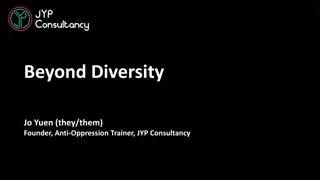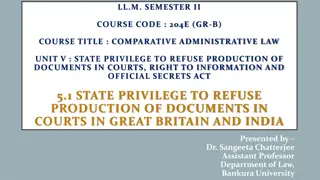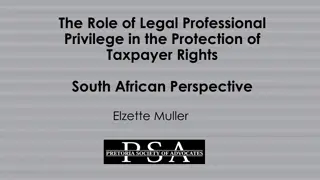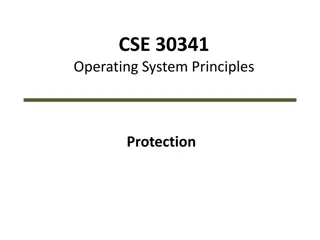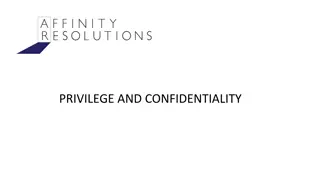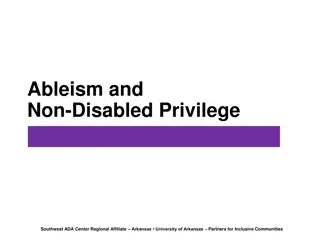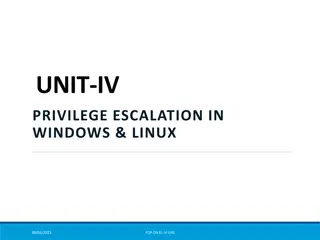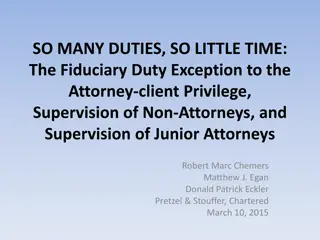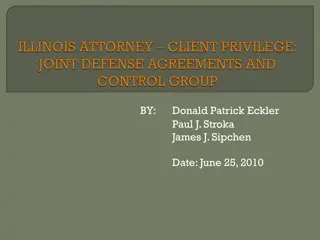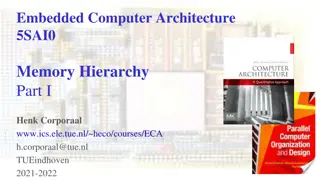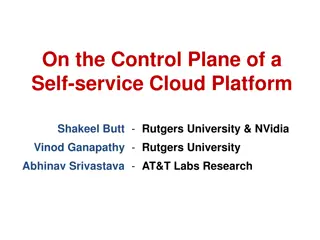Secure Architecture Principles and Least Privilege Concepts
Explore isolation, least privilege, and secure design principles in operating systems and browsers. Learn about compartmentalization, defense in depth, and system module privileges. Understand the importance of minimizing access rights for system modules.
Download Presentation

Please find below an Image/Link to download the presentation.
The content on the website is provided AS IS for your information and personal use only. It may not be sold, licensed, or shared on other websites without obtaining consent from the author.If you encounter any issues during the download, it is possible that the publisher has removed the file from their server.
You are allowed to download the files provided on this website for personal or commercial use, subject to the condition that they are used lawfully. All files are the property of their respective owners.
The content on the website is provided AS IS for your information and personal use only. It may not be sold, licensed, or shared on other websites without obtaining consent from the author.
E N D
Presentation Transcript
Spring 2018 CS 155 Secure Architecture Principles Isolation and Least Privilege Access Control Concepts Operating Systems Browser Isolation and Least Privilege John Mitchell
Secure Architecture Principles Isolation and Least Privilege John Mitchell
Principles of Secure Design Compartmentalization Isolation Principle of least privilege Defense in depth Use more than one security mechanism Secure the weakest link Fail securely Keep it simple John Mitchell
Principle of Least Privilege Principle of Least Privilege A system module should only have the minimal privileges needed for its intended purposes What s a privilege? Ability to access or modify a resource Assumes compartmentalization and isolation Separate the system into isolated compartments Limit interaction between compartments John Mitchell
Monolithic design Network Network User input User device System File system File system John Mitchell
Monolithic design Network Network User input User device System File system File system John Mitchell
Monolithic design Network Network User input User display System File system File system John Mitchell
Component design Network Network User input User display File system File system John Mitchell
Component design Network Network User input User device File system File system John Mitchell
Component design Network Network User input User device File system File system John Mitchell
Principle of Least Privilege Principle of Least Privilege A system module should only have the minimal privileges needed for its intended purposes What s a privilege? Ability to access or modify a resource Assumes compartmentalization and isolation Separate the system into isolated compartments Limit interaction between compartments John Mitchell
Example: Mail Agent Requirements Receive and send email over external network Place incoming email into local user inbox files Sendmail Traditional Unix Monolithic design Historical source of many vulnerabilities Qmail Compartmentalized design John Mitchell
OS Basics (before examples) Isolation between processes Each process has a UID Two processes with same UID have same permissions A process may access files, network sockets, . Permission granted according to UID Relation to previous terminology Compartment defined by UID Privileges defined by actions allowed on system resources John Mitchell
Qmail design Isolation based on OS isolation Separate modules run as separate users Each user only has access to specific resources Least privilege Minimal privileges for each UID Only one setuid program setuid allows a program to run as different users Only one root program root program has all privileges John Mitchell
Structure of qmail qmail-smtpd qmail-inject qmail-queue Incoming internal mail Incoming external mail qmail-send qmail-rspawn qmail-lspawn qmail-remote qmail-local John Mitchell
Isolation by Unix UIDs qmailq user who is allowed to read/write mail queue qmaild user qmailq qmail-smtpd qmail-inject qmail-queue qmail-send qmailr qmails root qmail-rspawn qmail-lspawn setuid user qmailr user qmail-remote qmail-local John Mitchell
Structure of qmail qmail-smtpd qmail-inject qmail-queue Reads incoming mail directories Splits message into header, body Signals qmail-send qmail-send qmail-rspawn qmail-lspawn qmail-remote qmail-local John Mitchell
Structure of qmail qmail-smtpd qmail-inject qmail-queue qmail-send signals qmail-lspawn if local qmail-remote if remote qmail-send qmail-rspawn qmail-lspawn qmail-remote qmail-local John Mitchell
Structure of qmail qmail-smtpd qmail-inject qmail-queue qmail-send qmail-lspawn qmail-lspawn Spawns qmail-local qmail-local runs with ID of user receiving local mail qmail-local John Mitchell
Structure of qmail qmail-smtpd qmail-inject qmail-queue qmail-send qmail-lspawn qmail-local Handles alias expansion Delivers local mail Calls qmail-queue if needed qmail-local John Mitchell
Structure of qmail qmail-smtpd qmail-inject qmail-queue qmail-send qmail-rspawn qmail-remote Delivers message to remote MTA qmail-remote John Mitchell
Isolation by Unix UIDs qmailq user who is allowed to read/write mail queue qmaild user qmailq qmail-smtpd qmail-inject qmail-queue setuid qmail-send qmailr qmails root root qmail-rspawn qmail-lspawn setuid user qmailr user qmail-remote qmail-local John Mitchell
Least privilege qmail-smtpd qmail-inject qmail-queue setuid qmail-send qmail-rspawn qmail-lspawn root qmail-remote qmail-local John Mitchell
Android process isolation Android application sandbox Isolation: Each application runs with its own UID in own VM Provides memory protection Communication limited to using Unix domain sockets Only ping, zygote (spawn another process) run as root Interaction: reference monitor checks permissions on inter- component communication Least Privilege: Applications announces permission User grants access at install time John Mitchell
Isolation: different apps under different UIDs App John Mitchell
Isolation: different apps under different UIDs UID1 UID2 App App John Mitchell
Privileges set at install time UID1, priv 1, priv 2, UID2, priv 3, priv 4, App App John Mitchell
Discussion? Principle of Least Privilege Qmail example Android app sandbox example John Mitchell
Secure Architecture Principles Access Control Concepts John Mitchell
Access control Assumptions System knows who the user is Authentication via name and password, other credential Access requests pass through gatekeeper (reference monitor) System must not allow monitor to be bypassed Reference monitor User process ? Resource access request policy John Mitchell
Access control matrix [Lampson] Objects File 1 File 2 File 3 File n User 1 read write - - read User 2 write write write - - Subjects User 3 - - - read read User m read write read write read John Mitchell
Implementation concepts File 1 File 2 Access control list (ACL) Store column of matrix with the resource Capability User holds a ticket for each resource Two variations store row of matrix with user, under OS control unforgeable ticket in user space User 1 read write - User 2 write write - User 3 - - read User m Read write write Access control lists are widely used, often with groups Some aspects of capability concept are used in many systems John Mitchell
ACL: my name is on the list John Mitchell
Capability: I have a ticket John Mitchell
ACL vs Capabilities Access control list Associate list with each object Check user/group against list Relies on authentication: need to know user Capabilities Capability is unforgeable ticket Random bit sequence (or managed by OS) Can be passed from one process to another Reference monitor checks ticket Does not need to know identify of user/process John Mitchell
ACL vs Capabilities Delegation Cap: Process can pass capability at run time ACL: Try to get owner to add permission to list? More common: let other process act under current user Revocation ACL: Remove user or group from list Cap: Try to get capability back from process? Possible in some systems if appropriate bookkeeping OS knows which data is capability If capability is used for multiple resources, have to revoke all or none Indirection: capability points to pointer to resource If C P R, then revoke capability C by setting P=0 John Mitchell
Process creation: ACL vs Capabilities User U Capabilty c,d,e Process P Process P User U Capabilty c,e Process Q Process Q User U Capabilty c Process R Process R John Mitchell
Roles (aka Groups) Role = set of users Administrator, PowerUser, User, Guest Assign permissions to roles; each user gets permission Role hierarchy Partial order of roles Each role gets permissions of roles below List only new permissions given to each role Administrator PowerUser User Guest John Mitchell
Role-Based Access Control Individuals Roles Resources Server 1 engineering Server 2 marketing Server 3 human res Advantage: users change more frequently than roles John Mitchell
Access control summary Access control involves reference monitor Check permissions: user info, action yes/no Important: no way to bypass this check Access control matrix Two implementations: access control lists vs capabilities Advantages and disadvantages of each Role-based access control Use group as user info ; use group hierarchies John Mitchell
Discussion? Access control matrix What are the advantages of access control lists (ACL)? What are the advantages of capabilities? Role-based access control Why is this helpful? John Mitchell
Secure Architecture Principles Operating Systems John Mitchell
Unix What access control concepts are used? Truncated access control list A form of role-based access control File 1 File 2 File 1 File 2 Owner read write - User 1 read write - Group write write - User 2 write write - Other - - read User 3 - - read Role r Read write write John Mitchell
Unix access control Process has user id Inherit from creating process Process can change id Restricted set of options Special root id All access allowed File has access control list (ACL) Grants permission to users Three roles : owner, group, other File 1 File 2 Owner read write - Group write write - Other - - read John Mitchell
Unix file access control list Each file has owner and group Permissions set by owner Read, write, execute Owner, group, other Represented by vector of four octal values Only owner, root can change permissions This privilege cannot be delegated or shared Setid bits Discuss in a few slides rwx rwx rwx ownr grp othr John Mitchell
Example directory listing access owner group size modification name John Mitchell
Process effective user id (EUID) Each process has three Ids (+ more under Linux) Real user ID (RUID) same as the user ID of parent (unless changed) used to determine which user started the process Effective user ID (EUID) from set user ID bit on the file being executed, or sys call determines the permissions for process file access and port binding Saved user ID (SUID) So previous EUID can be restored Real group ID, effective group ID, used similarly John Mitchell
Process Operations and IDs Root ID=0 for superuser root; can access any file Fork and Exec Inherit three IDs, except exec of file with setuid bit Setuid system call seteuid(newid) can set EUID to Real ID or saved ID, regardless of current EUID Any ID, if EUID is root Details are actually more complicated Several different calls: setuid, seteuid, setreuid John Mitchell
Setid bits on executable Unix file Three setid bits Setuid set EUID of process to ID of file owner Setgid set EGID of process to GID of file Sticky Off: if user has write permission on directory, can rename or remove files, even if not owner On: only file owner, directory owner, and root can rename or remove file in the directory John Mitchell




